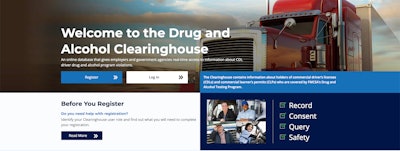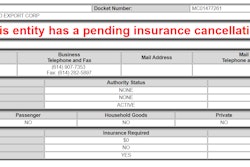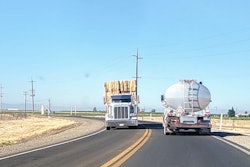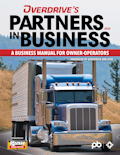
More than 178,000 truck drivers and other CDL holders who find themselves in “prohibited” status in the Federal Motor Carrier Safety Administration’s Drug & Alcohol Clearinghouse will have their licenses downgraded and their commercial driving privileges revoked on Monday, November 18.
This move is what FMCSA refers to as Clearinghouse II, or Phase 2 of its Clearinghouse that first launched at the beginning of 2020.
Up until now, drivers who have a failed drug or alcohol test reported to the Clearinghouse have been listed as “Prohibited,” but it’s up to their employer or prospective employer, or law enforcement at the roadside or scale house, to query the Clearinghouse and remove them from the road. Drivers can earn their way out of “prohibited” status by completing the required return-to-duty (RTD) process.
With the second phase of the Clearinghouse rule taking effect Monday, state driver licensing agencies (SDLAs) will be required to remove the commercial driving privileges of drivers in “prohibited” status in the Clearinghouse, which would result in a downgrade of the CDL until the driver completes the RTD process. Some states have already been conducting the automatic CDL downgrades ahead of FMCSA’s Nov. 18 compliance date. All states are required to do so beginning Monday.
“Effective November 18 of this year will be the next phase, which is to take [the Clearinghouse to] the next step and say, not only will you, CDL driver, be put into prohibited status in the Clearinghouse if you violate the drug or alcohol testing regulations, but [FMCSA is] also going to require your state licensing agency to strip you of your CDL because of that,” said Brandon Wiseman, president of trucking compliance firm Trucksafe Consulting. “And it makes sense to do that because if you get a drug or alcohol testing violation as a CDL driver, you’re prohibited from operating a commercial motor vehicle, so your CDL is doing you no good anyway.”
[Related: FMCSA tells states to ban drivers with drug, alcohol strikes]
Wiseman added that because there hasn’t been a CDL downgrade component to the Clearinghouse, in some cases “it looks like [drivers] are good to go if you’re just looking at their license and not their Clearinghouse status, despite the fact that they are prohibited from driving a commercial motor vehicle.”
Under Clearinghouse II, SDLAs must also query the Clearinghouse before issuing, renewing, upgrading, or transferring CDLs and issuing, renewing, and upgrading commercial learner’s permits (CLPs). SDLAs will also be required to review a driver’s information when notified by FMCSA of a driver’s Clearinghouse status change.
So, what does all of this mean for truck drivers and the trucking industry? Not much for those who have already been complying with the Clearinghouse requirements. According to FMCSA’s most recent monthly Clearinghouse report, updated through September 2024, as many as 178,839 CDL holders are going to lose their CDL on Monday, as they are in “prohibited” status in the Clearinghouse.
In reality, though, the industry shouldn’t be losing near that many active drivers, as those in the Clearinghouse are already prohibited from driving. The exception: cases where motor carriers aren’t running the required annual queries and, therefore, aren’t aware a driver is in the Clearinghouse.
Wiseman noted that for the carriers that haven’t been complying with the Clearinghouse regulations and running the required pre-employment and/or annual queries, Clearinghouse II closes a loophole in the regulation.
“Now this will be an additional check on the system, because [carriers are] also supposed to be running motor vehicle reports on all of their drivers, at least annually,” he said. “And now if those drivers are also losing their CDLs because of these drug and alcohol testing violations, even the carriers that haven’t been using the Clearinghouse should see the problem now, as they’re running their MVRs.”
[Related: Marijuana legalization, trucking, and the future of drug testing]
Wiseman said it’s less likely that fleets skirt the MVR requirement because, often, it’s required or even conducted by insurance companies.
“Certainly there are bad actors out there that aren’t even doing [MVRs], but a lot of times MVRs are driven by your insurance, as well, so a lot of insurers for small carriers are either running the MVRs on behalf of their insured customers, or at least mandating that the carriers do that,” he said. “I think a lot more carriers are bought into running MVRs than they are to the Clearinghouse." With Clearinghouse II, he felt, "we will see fewer drivers out on the road who shouldn’t be there.”
Independent owner-operators who are not part of a fleet's drug and alcohol program are required to be part of a drug-testing consortium, which conducts random drug tests of drivers it oversees. If a driver fails one of a consortium's random drug tests, the consortium is required to report that to the Clearinghouse, leading to the driver being put into prohibited status.
Since the start of the Clearinghouse in January 2020, only about a third of the 267,360 drivers who have ended up in prohibited status have completed the RTD process to to resume operating commercial vehicles.
Wiseman said that while the CDL downgrade may be a wake-up call for some who have continued operating in violation of the regulation to begin the process, he doesn’t “think it’s going to be a significant uptick. … They’re either out there working for a carrier that doesn’t care about the Clearinghouse and who hasn’t run [a query], or they have just left the market altogether and they’re doing something else.” He added that his suspicion is that “a lot of these drivers, assuming it will be harder for them to now get a CDL driving job, they’ll probably just leave the market, if I had to guess.”
[Related: Trucker's horror story with CBD, FMCSA's 'Return to Duty' and SAP program]
What’s next for carriers?
Wiseman said that while Clearinghouse II doesn’t have any new requirements for motor carriers/independent owner-operators, he is recommending to his Trucksafe clients that, if they’re not already using the Clearinghouse, they need to be. “Go in there, do the queries on all of your current CDL drivers and see which ones are in prohibited status, and then pull them off the road if they are in prohibited status. You should have been doing that all along, but now’s a good reminder to go ahead and do that.”
He also suggested that, after Clearinghouse II takes effect, fleets of all sizes should consider running new MVRs on their current drivers “to make sure that none of your universe of drivers have lost their CDL because of this rule.” If any of them have, “then you need to, number one, pull them from the road, because they can’t operate anymore; and number two, figure out why you didn’t catch that beforehand with a Clearinghouse query and start to fill those gaps.”
[Related: 'Fun' with safety/compliance: Low-hanging fruit to avoid FMCSA Clearinghouse violations]
For carriers that have been following the Clearinghouse requirements and running their annual queries, Wiseman said to keep doing what you’re doing. He said it’s not necessary to run a query more than the required annual query, because of “the way that the system notifies motor carriers of changes to an existing driver’s Clearinghouse status.”
Currently, if a carrier runs an annual query on a driver, and that driver applies to another motor carrier and tests positive on a pre-employment drug test, which should be reported to the Clearinghouse, the system will automatically notify the current employer that the driver’s status has changed.
“It will do that for a full 12 months after I ran that first query,” Wiseman noted. “The system does a good job now of automatically notifying carriers if the status of their driver changes within the 12 months after they ran a query. For that reason, I don’t think it’s necessary for them to run any more queries other than what’s required, which is once a year.”
[Related: FMCSA tightens reporting of drivers' drug and alcohol violation history]









